This was published 4 years ago
An all-female led tour across Kenya learning about female empowerment
By Isobel King
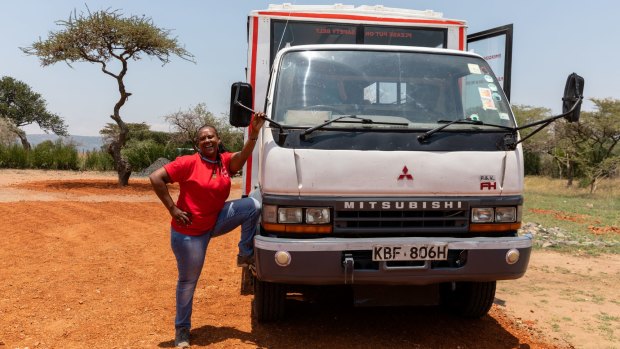
Becky, the first female overland truck driver in East Africa - and reluctant celebrity.
Hellen Nkuraiya is a proud Maasai and the modern face of Kenya's formidable women's movement. In this fiercely patriarchal society, it's feisty, courageous individuals like her that are shaping a brighter future for the next generation of young women.
For nearly two decades, in her local community near the vast Maasai Mara game reserve that borders Tanzania, this former schoolteacher has worked tirelessly for young girls and widows fleeing grim futures, giving them refuge and a path to financial self-sufficiency.
"I was saved, myself, by a nun, who gave me the gift of education, so if I can save even one or two girls, then that's enough," she says, with the kind of humility that downplays the magnitude of what she's accomplished.
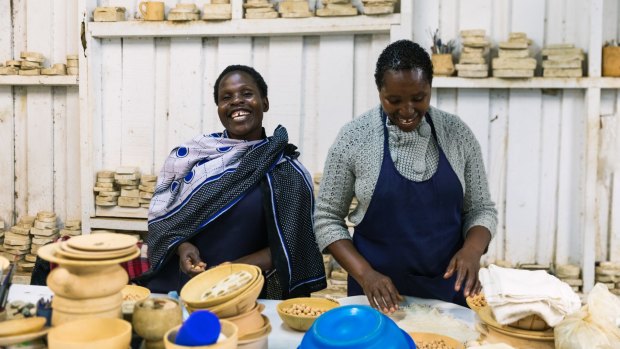
The Kazuri bead factory in Nairobi employs over 340 women, mostly single mothers.
In 2009 she founded Enkiteng Lepa Primary School where young girls, escaping female circumcision and marriage to men old enough to be their grandfather, receive an education and board.
We're gathered in a village Nkuraiya established for widows, but far from being a sombre place, these women radiate self-confidence, proudly showing off the mud houses they've built and which they share with their precious livestock. Long tables are laden with the decorative beadwork and textiles they sell to tourists. A group of young Maasai warriors mingle with us, spears, shields and sandles casually tossed to one side following a vigorous welcome dance.
Nkuraiya's message is definitely not anti-men; Enkiteng Lepa welcomes boys and she's keen to eventually build a dormitory for them at the school. Her quest is simply to educate the next generation of men and women about how to better align women's rights with traditional Maasai culture. "I want my people to hold culture with this hand, and education with the other," she says.
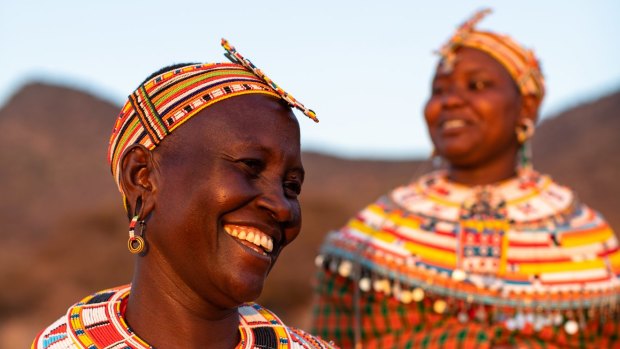
The Samburu and Maasai are closely linked, and both are famous for their highly decorative and colourful attire.
She is just one of the many strong, amazing women we meet on this pilot run of Intrepid's Kenyan Women's Expedition, which starts in mid 2020. The idea is that as an all-female cast, you can access opportunities not available to mixed-gender tour groups. Intrepid has rolled out similar women's tours in six other countries, including Iran, India and Jordan.
Kenya is a country in transition, enlightened thinkers battling centuries of tradition that have blatantly favoured menfolk. And it seems to have happened in one generation – the generation we're meeting. The internet and social media, together with access to mobile phones, means even those in remote communities can glimpse a world at odds with their own.
The trip is a rare chance to meet those communities at the forefront of change. There's the band of 340-strong women at Kazuri bead factory in Nairobi, who create beaded fashions that sell around the world. Started in 1975 to provide employment for local single women desperately in need of a stable income, it was a pioneering concept.
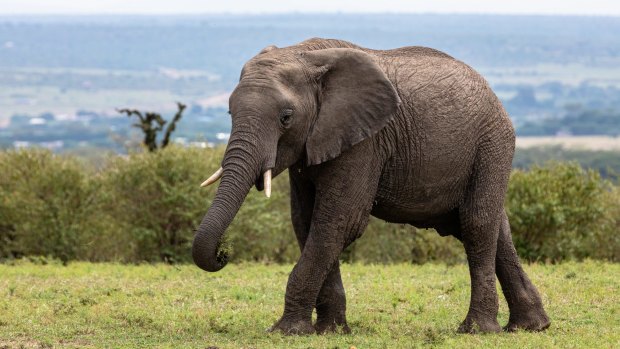
An elephant in one of Kenya's game reserves, Maasai Mara.Credit: Melissa Findley
On my first day in Nairobi, I'm driven past Kibera, reputedly one of the world's largest urban slums, on our way to visit grandmothers who have turned to pig farming as a way to escape abject poverty. They now support their families and give their grandchildren an education and a life they could only have dreamt of.
As I chat to a girl selling striped kikois (traditional woven cloth worn like a sarong) at a handicrafts store we stop at on one of the long drives through Kenya, she tells me the woman who owns the local enterprise has given her a share of the business so they can all benefit from the buoyant tourist trade.
I hear many moving stories over the course of this trip, and eventually the details give way to an overwhelming impression of women supporting other women in really practical ways that create sustainable incomes – a "pay it forward" mindset.As Darlene, our wonderfully worldly and witty Kenyan guide for the trip, points out, "empower a woman and you empower a village."
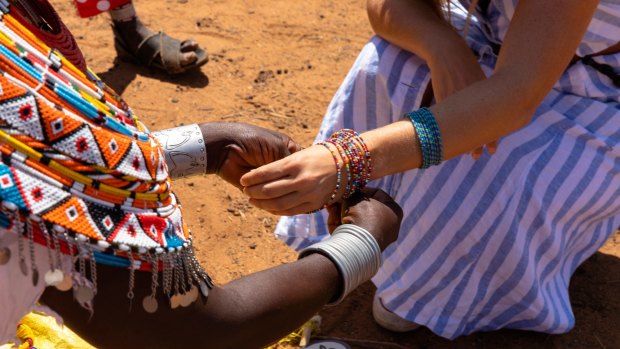
Selling handmade jewellery is a primary source of income for many Kenyan women.
One of the biggest political game changers came in 2013, with the decentralisation of Kenya's government into 47 counties, each with their own administrative structure which determines what projects go ahead and distributes funds at a local level. Every one of these counties has at least one female representative. And that means "influencers" like Hellen Nkuraiya have an ally in the government to help bring about change within their communities.
While polygamy is sanctioned in Kenya, female genital mutilation (FGM) was officially outlawed in 2011. However, it's still widely practised. An estimated one in five females aged 15 to 49 have undergone FGM. Nkuraiya puts the figure at 60 per cent among the staunchly traditional Maasai. The UN claims almost one in four girls in Kenya is married off before they reach the legal age of 18.
Clearly there's still a long way to go, but this trip inspires confidence that a seismic change is happening both at a grass roots and government level.
Our excursion through Kenya features a few lengthy drives, so brace yourself for some long hours on the road. It's not that the roads are bad; they're actually surprisingly good and mostly sealed. The issue is that heavy vehicles like ours are fitted with a compulsory speed limiter of 80 km/h. Combine that with endless roadworks and random speed humps on arrow straight stretches, and it's slow going. The upside is that it leaves plenty of time to bond with the sisterhood: rotate seats, share laughs and life stories, dissect the complexities of what we're encountering, and generally enjoy the freestyle banter of an all-gals tour.
Two of Kenya's game reserves, Maasai Mara and Samburu National Reserve, feature prominently on the 10-day itinerary, and provide me with some memorable highlights.
For a novice who has never experienced the thrill of a game drive, the safari ritual is an eye opener, from the startlingly different landscapes, to the pure wonder of seeing these wild beasts going about their business, oblivious to the army of vehicles and gawking tourists. I guess we're simply another herd to them. Taking a balloon ride at dawn over Maasai Mara, looking down in silence at herds of wildebeest scattering across the grassy plains and creeks, joined by impalas, zebras and curved horn topi, is something I won't easily forget.
Samburu National Reserve, in northern Kenya, is one of Kenya's lesser known parks. It's hot and dry with sparse, open plains and the muddy Ewaso Ng'iro River winding through it. Here I see my first African elephants grazing along the river banks with their young as we take respite from the heat in one of the luxury lodges within the reserve.
As we leave the park in the sublime streaks of sunset, a crowd of vehicles up ahead signals a sighting of some sort. It is a lioness – and she eventually lumbers out of the undergrowth and mooches across the road in front of us. Actually, we are extraordinarily lucky with both the variety and number of animals we see on our game drives, ticking off most of the big five.
The main reason we are in Samburu, however, is to visit Umoja, a refuge-cum-all-womens-village founded in 1990, which undoubtedly ignited the women's movement that has shaken up this arid, pastoralist region. Umoja and its occupants are now an internet sensation, as a quick Google search reveals. It's worth a read. Let's just say that visit didn't come off, but it doesn't take long for our reconnaissance mission to uncover a new women's enterprise to highlight.
At Sabache, the community-run eco camp where we stay, we meet Naomi Lekisaat, co-ordinator of some 30 women's groups in the area. We're introduced to the industrious women who sell their jewellery through our camp shop, taking home 100 per cent of the proceeds, and are invited to their nearby village. Widows, mainly through tribal warfare and disease, live peacefully here in simple huts they've built themselves. Their primary source of income are the goats that share the village and the jewellery they sell at the camp. They have their own informal table banking system, whereby the group provides loans to the women with a 10 per cent interest rate.
The mothers are grateful their children, who walk five kilometres to the local school, are being educated and have a shot at breaking the poverty cycle. Carol, 19, looks like she could strut any international catwalk, decked out in the colourful Samburu traditional dress and beads (the Samburu and Maasai are closely related). She's vivacious and articulate, and the first of the village to attend university, studying accountancy. Something tells me she's going to be a mover and shaker of this community when she graduates.
In Hellen Nkuraiya's village, there are two girls currently at university who graduated from Enkiteng Lepa: one is studying law, the other community development and project management. Both assure Nkuraiya they will return to join the cause.
Our driver for the lengthy hauls across Kenya is Becky, the first female overland truck driver in East Africa. Everyone gets a chance to sit up front with this reluctant celeb, as she navigates our people-mover between destinations and through game reserves. "I'm famous, yes!" she cheekily beams, as I refer to Intrepid's promotional video of her.
I discover she's one of 10 children, and the only one who had the opportunity to go to a local college. Her older sister financed her education, but died in a road accident in 1996. Her father was a truck driver, which is where she got her love of big rigs, and her mother a housewife. Money was always scarce. She's a single mother to 17-year-old Louis, who will be going to university soon.
Her story in so many ways mirrors that of the Kenyan women we meet over the course of this trip. If I was to paraphrase: Life has been tough, but it's good now, and my children are going to have a much better future.
TRIP NOTES
MORE
FLY
Emirates flies to Nairobi via Dubai. See emirates.com
TOUR
Intrepid's 10-day Kenya Women's Expedition costs from $3675 a person, twin-share, including transport, accommodation, local female leader and driver, some meals and most activities. Accommodation is a mix of hotels and permanent tented camps. First departure is 26 July 2020. See intrepidtravel.com/au/kenya/kenya-womens-expedition-123163
Isobel King travelled as a guest of Intrepid.
Sign up for the Traveller Deals newsletter
Get exclusive travel deals delivered straight to your inbox. Sign up now.